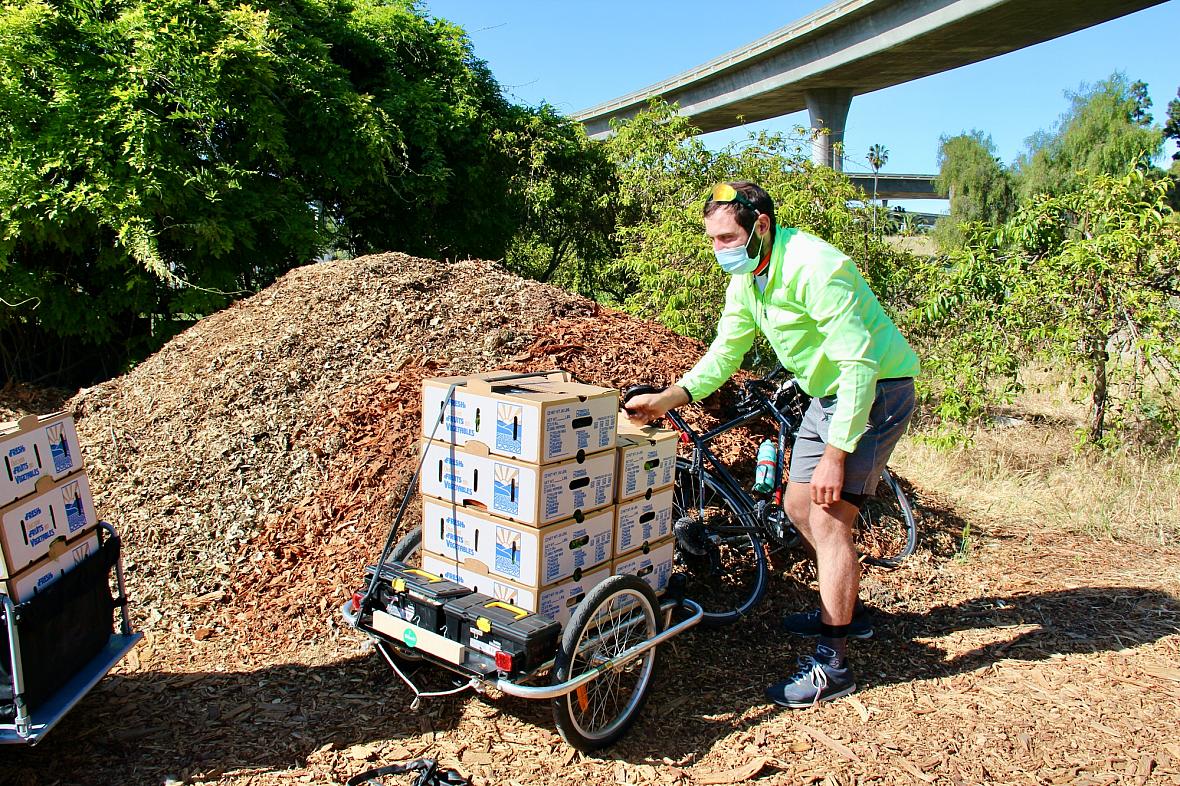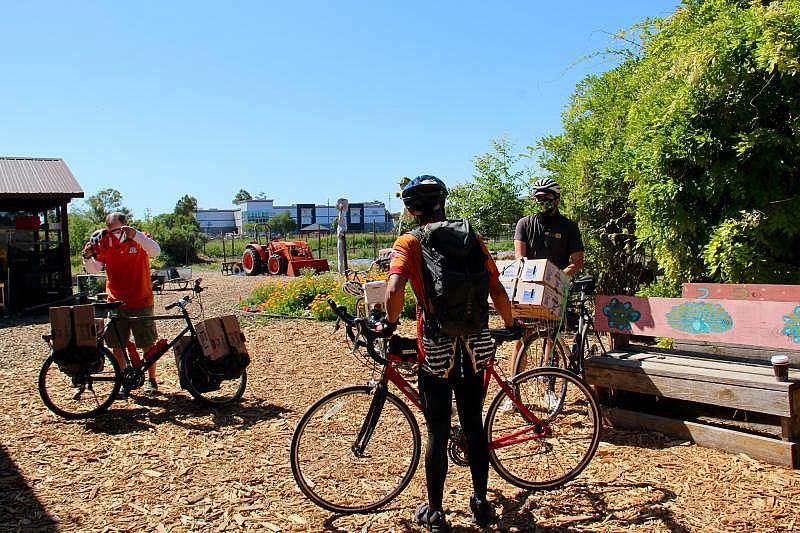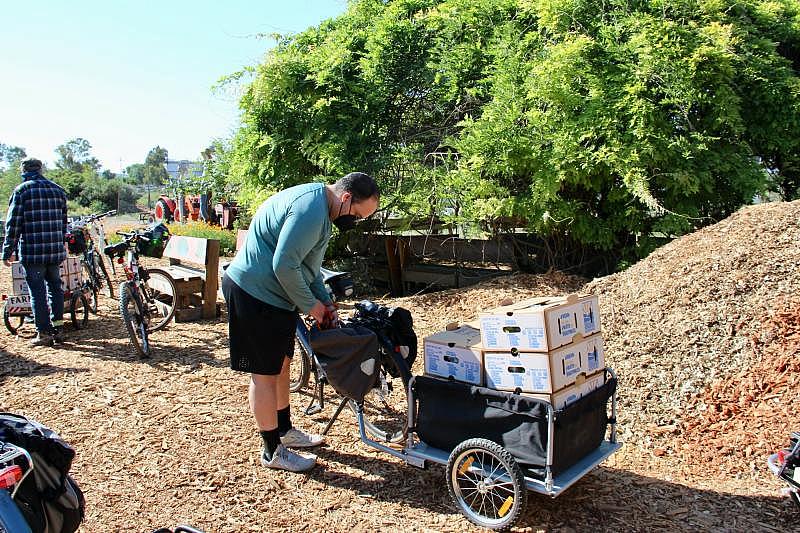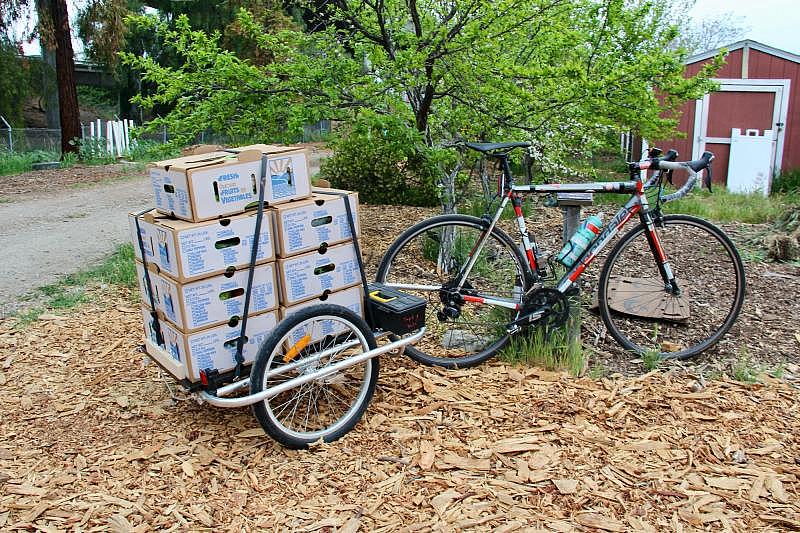When hazards collide: How local food systems are adjusting to a changing world
This article was produced as a project by Kate Bradshaw for the USC Annenberg Center for Health Journalism's 2020 Data Fellowship. It is the third in a series exploring the impacts of the COVID-19 pandemic on local food systems and policies.
Her other stories include:
Part 1: Figuring out how to feed kids when they're not in school
Part 2: From farms to families
Part 3: Federal program that helps farmers during the pandemic is changing the local food landscape

Volunteers with the Silicon Valley Bicycle Coalition load boxes of food onto their bicycles for delivery to households in San Jose on May 1, 2021. The program is a partnership with urban farm Veggielution and other local farms
Courtesy Silicon Valley Bicycle Coalition.
On March 6, 2020, just 10 days before the COVID-19 pandemic triggered California's shelter-in-place order and upended the world as we knew it, the Environmental Justice and the Common Good initiative convened a workshop with about 38 groups from public health, community-based groups and local farms to discuss food justice locally.
There, where handshakes were swapped for elbow bumps and a buffet lunch became a bagged one, the event planted the seeds for connections and relationships between organizations that would flourish through a disruptive year and grow into what's now known as the South Bay Food Justice Collaborative, according to Christopher Bacon, associate professor of environmental studies at Santa Clara University. Bacon co-founded the Environmental Justice and the Common Good Initiative at the university, which focuses on doing research that engages the community on pressing topics related to environmental justice.
The event, which included the University of California Cooperative Extension and community-based food justice groups like Fresh Approach, La Mesa Verde, Valle Verde and Veggielution, was about the "last in-person event that happened on our campus before the lockdown started," said Bacon.
Members of the collaborative have continued to meet every two weeks, and it hasn't been led by any particular group or entity, he said. Partly because of that, he reasoned, organizations let their guards down and the competition that often builds up between nonprofits, particularly those forced to battle over too little funding from too few sources, dissolved in the face of the regional hunger crisis. The regular meetings enabled the groups to network and start their own collaborations.
As communities emerge from the pandemic, local thought leaders like Bacon are asking whether this is a turning point that could trigger a revolution that changes local food systems for the better, or whether the hazards that farms face — not just in recovering from the pandemic but from the looming impacts of climate change — pose an existential threat.
It's a salient question not just for farmers and those in the food industry but eaters, too, especially as the current drought makes headlines and dry conditions worsen the likelihood of devastating fire seasons to come.
Innovations
Some cyclists without bike trailers joined the delivery bike trips at the Eastside Connect session on May 1, 2021. Courtesy Silicon Valley Bicycle Coalition.
Across the south bay, there are innovations sprouting up aimed at tackling differnet problems in the food system, specifically around the nexus of farm foods, food waste and food aid.
On the more conceptual side of the spectrum, there are growing initiatives to both declare food as a human right statewide or treat food as medicine.
Earlier this year, state Sen. Melissa Hurtado of District 14 — an area of California that includes parts of Fresno, Kern, Kings and Tulare counties — proposed Senate Bill 108, which asserts: "Every human being has a right to access sufficient, healthy and affordable food."
One-third of global food production is at risk due to climate change, according to Hurtado. Given rising costs of energy, a growing population in California and shifting land usage, "We must make sure the people in our state are fed now and in the future," she explained in remarks about the bill.
In a local initiative, Stanford University is home to the Food for Health Equity Lab, which is focused on generating evidence about how healthy foods impact chronic disease that can inform community health centers, according to the program's website.
Food aid
A volunteer adjusts something on a bicycle before setting out to make food box deliveries through the Eastside Connect program on May 1, 2021. Courtesy Silicon Valley Bicycle Coalition.
Funded through a grant from the Santa Clara Valley Open Space Authority, cyclist volunteers from the bicycle coalition deliver produce boxes from Veggielution to families in east San Jose who aren't able to pick up the food boxes themselves.
Veggielution was initially part of the federal Farmers to Families food box program described in part two of this series, but when that federal contract ended, funding through the city of San Jose allowed it to continue serving local families. The program started with just 40 families getting farm boxes, but expanded to 250, according to Emily Schwing, public affairs director at Veggielution. With the additional boxes, the program partnered with a number of other local farms, including Spade & Plow, an organic farm in the Santa Clara Valley, to supply the larger volumes of produce needed.
Situated inside the Emma Prusch Farm Park in San Jose's Mayfair neighborhood, the Veggielution farm sits in the shadows of an overpass, a colorful and friendly oasis with picnic tables, peacocks, roosters and flowers.
The expansion by the bicycle coalition into a community it's not as familiar with triggered coalition leaders to reach out to leaders focusing on diversity, equity and inclusion, said the coalition's executive director, Shiloh Ballard, in a blog post. Without being sensitive to the dynamics, it might look like a "white savior" situation, with mostly white cyclists bringing food to residents in a neighborhood where about 70% of people are Latino and about 22% are Asian or Pacific Islander.
One way they are working to build more egalitarian relationships within the community was to invite nonprofit leaders from east San Jose to join the cyclists and encourage mutual exchanges of information, Ballard said.
And while the program isn't particularly efficient — the three, one-hour volunteer sessions involved about 19 volunteers to deliver 41 food boxes on bike trailers within a roughly 10-mile radius — it is a creative partnership that gets people to help out, exercise and learn about a new neighborhood from those who know it best. According to Violeta Palatto, engagement and development officer at the bicycle coalition, the volunteer sessions are popular and fill quickly.
Volunteer Jon Williamson was already back at the second event in May after attending the first in April, this time with his wife, Miki Chang, to deliver four boxes. He said he enjoyed the experience because he got to explore unfamiliar parts of San Jose and help neighbors.
Reducing waste
Volunteers load a bicycle trailer with food boxes to deliver to households in east San Jose on May 1, 2021. Courtesy Silicon Valley Bicycle Coalition.
When food waste goes in landfills, it breaks down to produce methane, a greenhouse gas that accounts for about 20% of global emissions. The U.S. Department of Agriculture estimates that between 30% and 40% of the food supply becomes waste.
Senate Bill 1383, passed in 2016 in California, is aimed at curbing emissions from reducing the amount of food waste and sets clear targets to, by 2025, reduce organic waste disposal by 75% from 2014 levels and rescue at least one-fifth of the currently disposed edible food.
Starting on Jan. 1, 2022, regulations that CalRecycle has established to meet those goals take effect, and jurisdictions are expected to have programs in place to work toward those goals. Among the mandated programs are a requirement for jurisdictions to offer compost pickup to all residents and businesses and to establish an edible food recovery program for certain types of businesses that generate edible food that may be wasted.
Compliance for "tier one" food generators, including supermarkets and large grocery stores, starts in 2022; for "tier two" food generators, like large restaurants, hotels or health facilities with cafeterias or on-site food service, it starts in 2024.
However, figuring out what those generators are in Santa Clara County was its own project. Bacon mentored a team of students through a project to identify the tier one generators countywide, and found that it took more than 45 hours of analysis to narrow down a list received from the Environmental Protection Agency and other agencies into one the county can use moving forward, he said.
Conclusions
Cyclists meet at the garden facilities at the Veggielution Community Farm in San Jose before departing as individuals or small groups to make food box deliveries on May 1, 2021. Courtesy Silicon Valley Bicycle Coalition.
While the hardships facing the food system are not likely to abate any time soon, Bacon said there are some positive shifts he's seen recently.
For instance, the pandemic has prompted a resurgence of interest in CSA, or community-supported agriculture farm boxes, and it has brought continued recognition that access to fresh fruits and vegetables is important from a public health perspective. On his campus, he said, he's seeing students reducing their meat consumption for health and environmental reasons.
The next time the collaborative gets to meet in person, Bacon said, the plan is to organize a field trip and workshop to learn about local indigenous agricultural knowledge and practices from the Amah Mutsun tribe.
However, whether the initiatives develop into anything bigger remains to be seen.
Santa Clara County policymakers appear to be starting to work toward a more comprehensive approach to support local food systems.
At the county Board of Supervisors' May 4 meeting, the board received a report from staff that laid out 12 recommendations for strengthening the resiliency of the local food system.
The steps focus around the larger goals of creating an internal working group of county agencies, to be called the "Kitchen Cabinet," that aims to improve coordination between departments; establishing a new countywide Food Systems Leadership Collaborative to connect the Kitchen Cabinet to cities and existing food system programs; and forming a new advisory council made up of residents from vulnerable neighborhoods to guide policymaking around food equity.
Other recommendations included creating program manager and management analyst positions to help lead those efforts, taking steps to permit farming on suitable public land, creating a plan to prepare for and respond to crises that disrupt food security, and working to boost enrollment in CalFresh, California's federal supplemental food assistance program.
A bicycle with a trailer affixed to the back is loaded with food boxes to deliver during a Saturday morning session of the Eastside Connect program led by Veggielution and the Silicon Valley Bicycle Coalition on April 3, 2021. Courtesy Silicon Valley Bicycle Coalition.
Equity is one topic that interests and concerns Bacon as well.
"Not only do we have an increasingly widely recognized need for racial justice, but we also have the climate crisis bearing on us headfirst," he said. "I think there is a new opening for building back more equity into these systems."
That could mean expanding urban agriculture, which can reduce air pollution and lower the temperature in urban areas that retain heat due to limited greenery and dense infrastructure. Or, to boost farms' resilience during droughts, shifts toward dry farming and finding more ecologically efficient farming practices could also help, he said.
But making those changes, he argued, is going to take political engagement from the broader citizenry, alongside research like his own. "Is there a critical political and economic interest that's going to see it through? I do have some concerns," he said.
Bacon said he draws inspiration from a woman named Maria Catalan, who was one of the first local Latina farmworkers to own her own farm, which became organic-certified in the mid-2000s.
She lost her farm when a 2014 drought dried up the well, he said. She's been renting land and continuing to produce organic vegetables, and was able to participate in the Pie Ranch and Veggielution farm box programs (described in part two of this series). He said he asked her how she got the strength to respond to the adversity she'd faced, and she said that it came down to her love of people, land and the work she was doing.
Whatever plan to transform the food system comes next, he argued, it will need to have an equitable path forward for workers, especially those who have had to work in parts of the industry that are more extractive and polluting.
"That's a gap that needs to be both researched and invested in on multiple levels," he said.
"We didn't revolutionize the food system yet, but we may have taken a few steps in that direction."
This article was produced as a project for the USC Annenberg Center for Health Journalism's 2020 Data Fellowship. It is the third and final article in a series exploring the impacts of the COVID-19 pandemic on local food systems and policies. Email Staff Writer Kate Bradshaw at kbradshaw@almanacnews.com.
[This article was originally published by Palo Alto Online].
Did you like this story? Your support means a lot! Your tax-deductible donation will advance our mission of supporting journalism as a catalyst for change.

